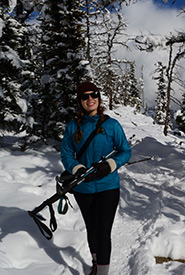Skis with wolves
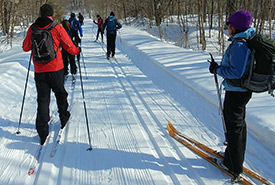
Cross-country skiing in search of wolf tracks on the Kenauk property (Photo by Jaimie Vincent)
What do you get when you combine a picturesque winter forest landscape, cross-country skiing, snowshoeing and wolf surveying? A dream trip is what I would have said just a few weeks ago. The answer, however, is a very real adventure that I experienced, thanks to the Nature Conservancy of Canada’s Conservation Volunteers (CV) program.
Around mid-January, a call came out for volunteers to participate in a wolf survey on NCC’s Kenauk property, which is less than an hour away from my house. This was the first CV event that I had ever participated in, and I was very excited, to say the least.
We arrived on the property at 9 a.m. on a Saturday in mid-February. All the volunteers assembled in the cozy cottage room, where we were given information about the history of the property and how NCC has been stewarding the protected land. Our tasks for the day were to look for eastern wolf tracks and to collect any urine, scat and fur samples left behind by this species. These samples would later be used to analyze the genetic makeup of the wolves inhabiting the property.
Related blog posts
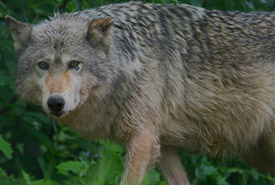
Eastern wolf (Photo by Manuel Henriques)
Hybridization, the process where two distinct but closely related species mate with each other and reproduce successfully, is a concerning threat for eastern wolf populations. Eastern wolves are closely related enough to coyotes that mating is possible between the two species. Habitat loss has forced these species to come into closer contact with each other, and it has amplified the chances of creating hybrid offspring (i.e., the offspring of a coyote and an eastern wolf).
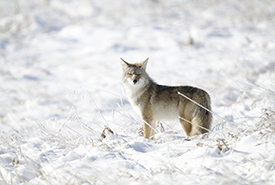
Coyote (Photo by Paul Turbitt)
Genetically speaking, pure eastern wolves are becoming more scarce as pressure from human development increases. Because a wolf had been spotted on one of the Kenauk property’s trails over the holidays, we were very interested in figuring out how the wolves were occupying the property and to what degree they had hybridized with coyotes.
We were split up into two teams: a snowshoe team and a ski team. We then headed off onto our respective trails. Both teams were guided by a leader skilled at identifying wolf tracks in the snow and familiar with the sampling protocol.
It really was a splendid winter day; a balmy –5 C with no wind and clear blue skies. This was a blessing for mid-February weather in the Outaouais region and ideal for slow-paced skiing and snowshoeing. It hadn’t snowed in a few days, which made it easier to see wildlife tracks and identify which species they belonged to.
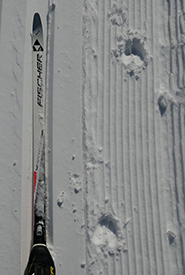
Moose tracks in the snow on the Kenauk property (Photo by Jaimie Vincent)
Within the first 10 minutes, we found our first tracks. After a little debate, we hypothesized that a fisher had left those tracks based on their size and shape. Further along our path, we observed fresh moose tracks. These eventually continued off the ski trail and into the forest, where the moose’s hefty body had compressed the deep snow. The moose had probably heard our travelling party from a distance and retreated to a more secluded area. As we continued on our adventure, we encountered many other tracks left by a variety of animals, such as squirrel, snowshoe hare and grouse.
We completed the trail by 2 p.m., having found no evidence of wolf presence. However, the snowshoe team radioed in to let us know that they had successfully collected scat and a urine sample on the trail. This was very exciting news!
Even though our ski team didn’t find what we had initially set out looking for, we had an incredible time taking in the wonderful forest landscape and searching for tracks on the Kenauk property’s trails. I’m very excited to find out more about the eastern wolves here and to see how NCC will use the new genetic data to conserve this charismatic species.

